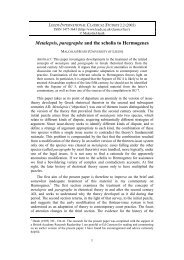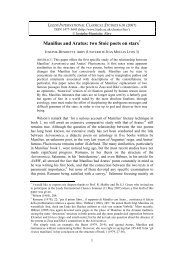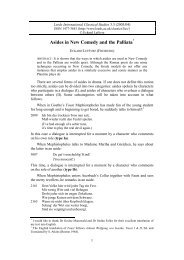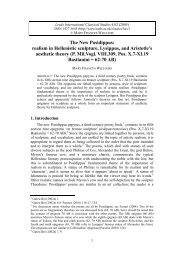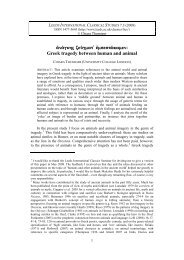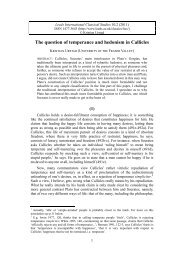Revisiting Tarpeia's myth in Propertius (IV, 4) - Leeds International ...
Revisiting Tarpeia's myth in Propertius (IV, 4) - Leeds International ...
Revisiting Tarpeia's myth in Propertius (IV, 4) - Leeds International ...
You also want an ePaper? Increase the reach of your titles
YUMPU automatically turns print PDFs into web optimized ePapers that Google loves.
MYRTO GARANI, REVISITING TARPEIA’S MYTH IN PROPERTIUS (<strong>IV</strong>, 4)<br />
ground the gra<strong>in</strong> to make the mola salsa and their donkeys; the episode was<br />
commemorated dur<strong>in</strong>g the festival of Vestalia (June 9-15). This <strong>myth</strong> is the only<br />
context <strong>in</strong> which Vesta—who otherwise is represented by a flame, not an<br />
effigies—appears ‘<strong>in</strong>corporated’ <strong>in</strong> a womanly form. <strong>Propertius</strong> offers just a h<strong>in</strong>t at<br />
this tale which is later developed <strong>in</strong> Ovid’s Fasti (Fasti 6.309-18). 23 In this way,<br />
<strong>Propertius</strong> can endow her with an energetic role <strong>in</strong> the story of Tarpeia. More<br />
importantly, given that her association with donkeys contradicts her solemn<br />
nationalistic character, a lurk<strong>in</strong>g element of farce is <strong>in</strong>troduced <strong>in</strong>to her<br />
<strong>myth</strong>ology. This playful dimension which coexists with the chaste one shakes the<br />
certa<strong>in</strong>ty of the reader about Vesta’s expected behaviour.<br />
Tak<strong>in</strong>g <strong>in</strong>to consideration, therefore, both Vesta’s Neopythagorean<br />
connections, which associate her with (Empedoclean) Venus and her fluctuat<strong>in</strong>g<br />
identity, this potentially be<strong>in</strong>g either solemn or playful, chaste or erotic, we may<br />
turn to the rest of the elegy.<br />
Just after the verses describ<strong>in</strong>g Vesta’s <strong>in</strong>tervention, the narrator <strong>in</strong>troduces a<br />
simile (71-2):<br />
illa furit, qualis celerem prope Thermodonta<br />
Strymonis abscisso pectus aperta s<strong>in</strong>u.<br />
She goes mad, like a Thracian bacchant beside the swift Thermodon, her clothes<br />
torn to reveal her breast.<br />
In her frenzy, Tarpeia is compared with a Strymonian bacchant on the banks of the<br />
Thermodon. This image strik<strong>in</strong>gly merges the figure of a Thracian woman with<br />
that of an Amazon. How can one account for such a <strong>myth</strong>ical conflation? To beg<strong>in</strong><br />
with, <strong>in</strong> the Aeneid the dwell<strong>in</strong>g place of Jupiter on the Tarpeian hill was po<strong>in</strong>ted<br />
out to Aeneas by Evander (Aen. 8.347). 24 This allusion to Vergil is thus consonant<br />
with <strong>Propertius</strong>’ plan to accommodate Vergilian epic with<strong>in</strong> the conf<strong>in</strong>es of<br />
elegy. 25 More importantly, <strong>Propertius</strong> engages with the Vergilian <strong>in</strong>tertext <strong>in</strong> a<br />
more <strong>in</strong>tricate way: as scholars have already po<strong>in</strong>ted out, by means of this simile<br />
Tarpeia harks back to another female figure who is tortured by desperate love, the<br />
Vergilian Dido (Aen. 4.300-3): 26<br />
23<br />
Fantham (1983) 207: ‘There was only one context <strong>in</strong> which Vesta was regularly represented <strong>in</strong><br />
womanly form, and this was the lararia of bakers or millers. Here as the rema<strong>in</strong>s of Pompeii show,<br />
she was usually portrayed veiled and hold<strong>in</strong>g a scepter and patera for libation and accompanied by<br />
a donkey.’ On this basis, Ovid also narrates a <strong>myth</strong>ical episode, accord<strong>in</strong>g to which Priapus<br />
attempted to rape the sleep<strong>in</strong>g Vesta, but the bray<strong>in</strong>g of Silenus’ donkey woke her up and saved<br />
her (Fasti 6.319-48). For Ovid’s treatment of the <strong>myth</strong> of Vesta and Priapus see Fantham (1983)<br />
201-9; Newlands (1995) 124-45. Regard<strong>in</strong>g Vesta’s paradoxical sexual nature, it is also worth<br />
mention<strong>in</strong>g that <strong>in</strong> Ovid’s Priapus <strong>myth</strong>, while Vesta’s failed rape highlights her connection with<br />
fertility, the donkey preserves her chastity, even though as an animal it is renowned for its sexual<br />
licence: see Priap. 52.9; Juv. 9.92 with Mills (1978) 304-5.<br />
24<br />
A certa<strong>in</strong> Tarpeia is also named among the companions of Camilla (Aen. 11.655-8).<br />
25<br />
Wyke (1987a) 162.<br />
26<br />
Warden (1978); Hutch<strong>in</strong>son (2006) 132. For verbal cross-references between the Tarpeia elegy<br />
and the Vergilian Dido see Reisch (1887) 140-1; La Penna (1950) 215 n.1. Translations from<br />
Vergil are by Fairclough (revised by Goold, 1999-2000).<br />
6



